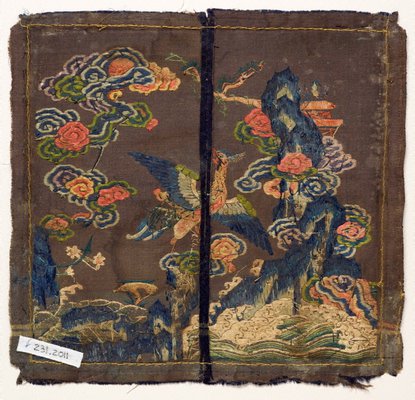-
Details
- Place where the work was made
-
China
- Period
- Yongzheng 1723 - 1735 → Qing dynasty 1644 - 1911 → China
- Date
- circa 1700-circa 1750
- Media category
- Textile
- Materials used
- embroidered silk
- Dimensions
- 22.5 x 24.0 cm
- Credit
- Gift of Dr David Ling 2011. Donated through the Australian Government Cultural Gifts Program.
- Location
- Not on display
- Accession number
- 231.2011
- Copyright
- Share
-
-
About
Rank badges were insignia badges worn by court officials to signify their status in the civil or military sphere. Two badges were attached to the costume, one on the back the other on the front which was split to allow the garment to be buttoned up at the front.
The badges were first introduced during the Ming period in 1391. From the Ming (1368-1644) to the Qing dynasty (1644-1912) the styles of the badges changed dependent on the tastes of the times - not necessarily only when the court dress regulations were published in 1652 and revised by Qianlong emperor in 1759. The best indicator of the time period of a badge are background elements such as water and cloud designs, as these could indicate what was fashionable at the time.
Civil rankings were based on the passing of demanding official examinations. Civil badges consisted of nine ranks each represented by a different bird, with only a couple of changes of bird types over the two dynasties. Military examinations were based on physical feats rather than literary and the rank badges are rarer. For example, towards the overturn of the Qing, military rank badges in particular were burnt to conceal identification. Military badges consisted of animals representing rank. During the Qing rank badges were generally worn by an official, his wife or wives and unmarried sons and daughters (Garrett 37).
This badge depicts a rare mandarin duck insignia, worn by a civil official of the 7th rank. The duck is shown about to alight from a rock which is surrounded by waves. It turns to look at the sun which is the symbol of the emperor. Included in the scene is a mountain, pine tree and a pavilion – the home of the Immortals. This complex badge, worn at the front due to the fact that it is split, is a significant example of a rank badge of the 18th century.
LITERATURE:
Schuyler Cammann, ‘The development of the Mandarin square’, 'Harvard Journal of Asiatic Studies", vol.8, no.2 (Aug. 1944), pp. 71-130.
Valery M. Garrett, 'Mandarin Squares', Oxford University Press, 1990.
Valery Garrett, 'Chinese dress from the Qing dynasty to the present', Tuttle Publishing, Singapore, 2007.Asian Art Department, AGNSW, June 2011.
-
Places
Where the work was made
China
-
Exhibition history
Shown in 2 exhibitions
A mark of excellence, Linda Wrigglesworth Ltd., London, 09 Jun 2006–21 Jun 2006
One hundred flowers (2011), Art Gallery of New South Wales, Sydney, 01 Sep 2011–15 Jan 2012
-
Bibliography
Referenced in 1 publication
-
Linda Wrigglesworth, A mark of excellence: explores the elegant purse, hat and aristocratic badge of rank, London, Jun 2006, 35 (colour illus.). cat.no. 8725
-

